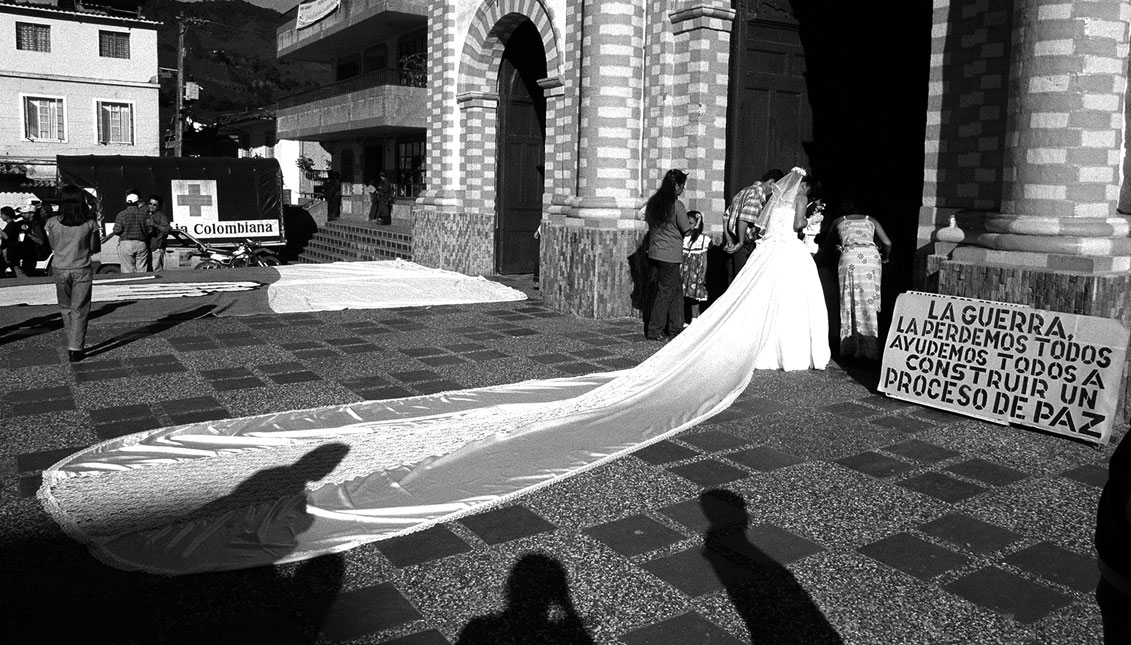
Pulses of the soul: The photography of Jesús Abad Colorado
In a country where we learned its geography by the names of the massacres, Jesús Abad Colorado is taking us on a journey to see it through the eyes of his…
“El Testigo” by Colombian photographer Jesús Abad Colorado, opened on October 20 of last year and might be, without exaggeration, the exhibition that has had the greatest impact on Bogotá's society. Proof of this is that it will go from an initial duration of three months to be programmed for over a year — but its significance is testified to, perhaps more importantly, by the torrent of over 280,000 people who have travelled through it in silence and continue to do it six days a week.
The 557 images that compose “El Testigo” record 25 years of armed conflict in Colombia, and are currently displayed in the Cloister of San Agustín, of the National University of Colombia in Bogotá, just next to the Palacio de Nariño: a direct message to the ruling class of this country, that Jesus regards with so many reservations.
Entering the first of the four rooms, a forest of black and white photographs opens up, interrupted by an imposing Miler Lagos’ installation: two trees built with more than 40 tons of recycled newspaper, which give a strange sensation of consolation for the memory of nature, but dislocated for being a still life. Among the meanderings of its roots, the public walks — watching, moved, sometimes even crying, the photos of peasants and indigenous people, children and old people fleeing violence, nature attacked by the war, paramilitary combatants at the time of surrendering arms, crying as if they were learning to be born.
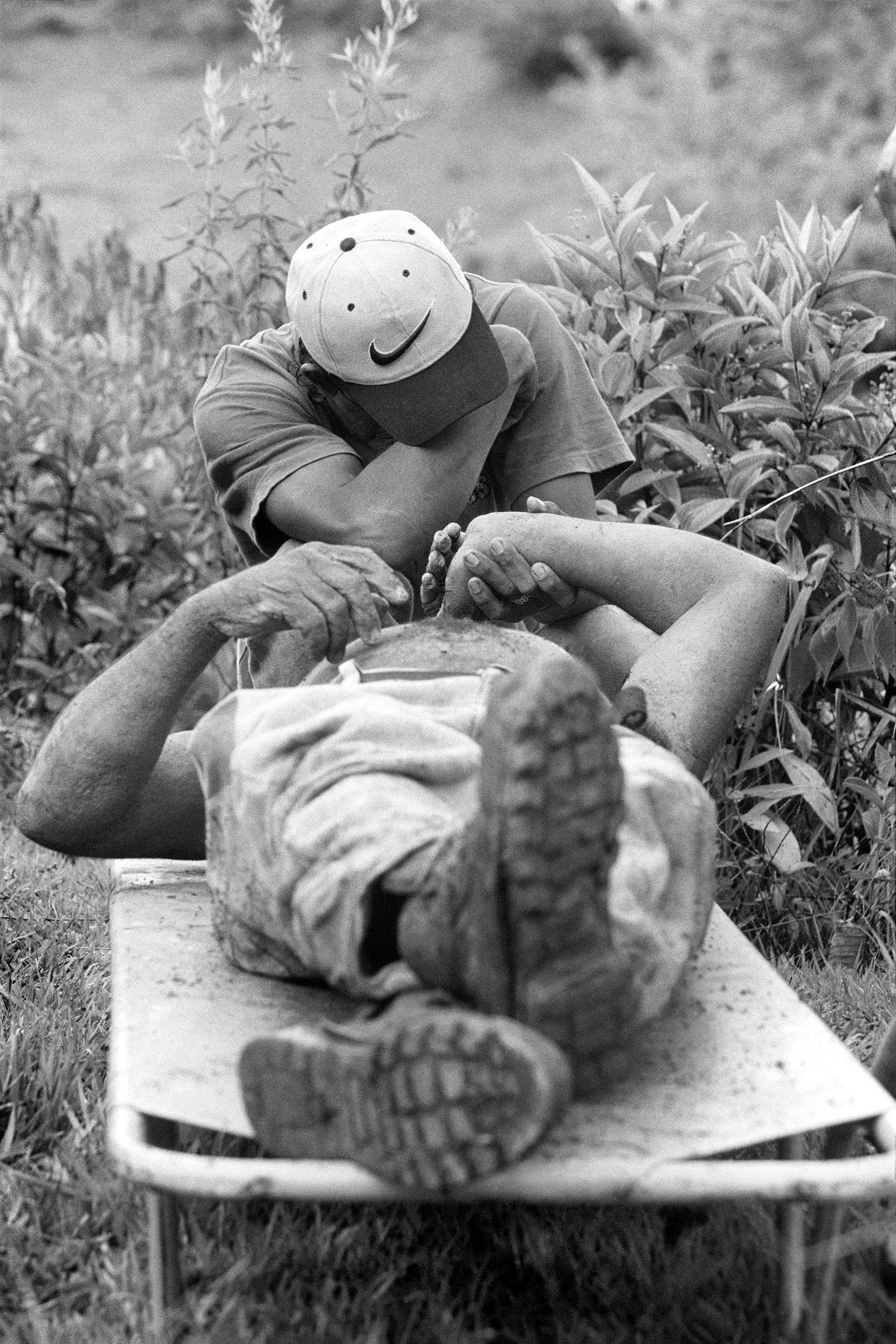
After that first room one moves forward, overwhelmed by the encounter with the other images, but with a sense of solidarity.
"I have to see them, even if it hurts.” The other rooms exhibit photos of forced disappearance and the search for loved ones, acts of violence against the civilian population, and the latest: images of the peace process carried out during the Santos administration. Braided to pain, all these photos carry the resilience of the Colombian people and a deep love that does not succumb.
Jesús talked to AL DÍA about the creation of the exhibit, his career as a photojournalist, and more.
Please help us introduce you to those who don't know you. Who is Jesús Abad? How did you come to cover the conflict in Colombia, and why through photography?
My last names are Colorado López, my name is Jesús Abad. I am the son of a peasant family that fled the municipality of San Carlos, Antioquia, to Medellín after my grandparents and an uncle were killed in the year 1960.
The guerrillas had not yet emerged, and it was at that time Colombia’s violence history where being liberal was a crime and my grandparents and my father were liberals in a very conservative region. My father, when he fled with my mother to the city, already had four children, five including a foster sister, and in Medellín three of us were born. So, we are eight children, plus father and mother.
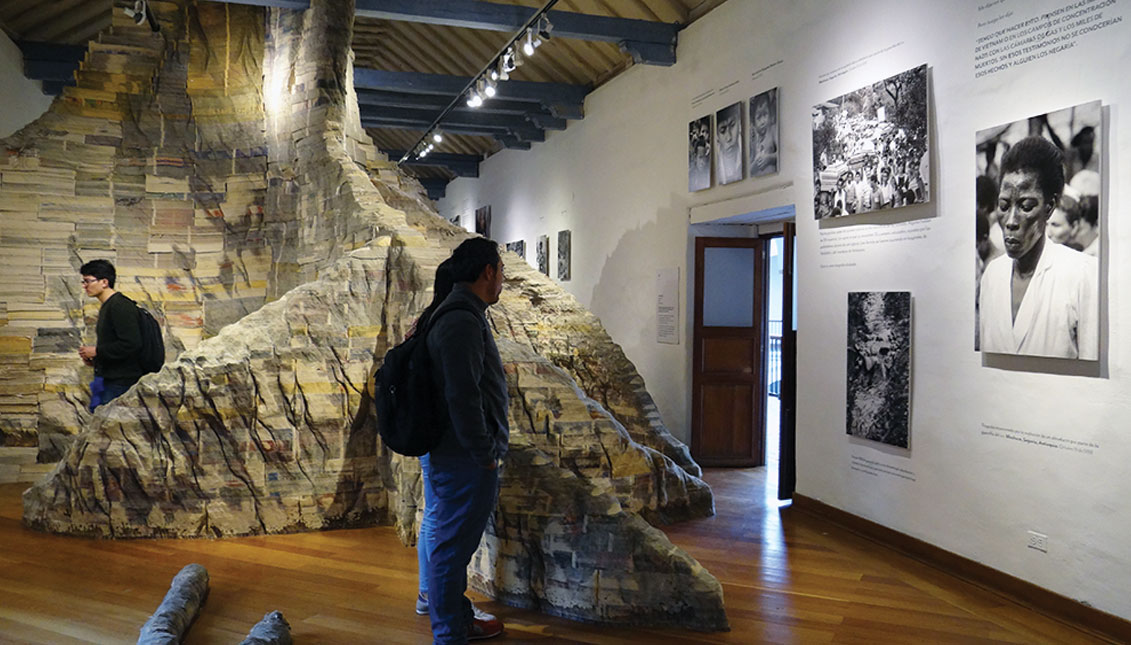
My mother had been a novitiate and was a school teacher in a region eight hours away on horseback in San Carlos. There she met my father in the 50s, who had studied up to the third grade of primary school. When they fled to the city, my father arrived in very difficult conditions, displaced by the war and, from several jobs he had, the one that helped him transform himself as a person, being a man of very good principles, was the National University. My father worked at the National University as a builder. He started working in 1961 and that educated us all a lot. I grew up accompanying my father to the university, almost learning to read by reading the walls, the graffiti of the social movements and the protests. And it helped me a lot. I am a sum of faces of that family of peasant origin, supportive, loving, with a mother who, having gone through the novitiate for four years and with some other religious people in the family, always lifted us up in the faith that things were going to get better, in the vein of hope. A very loving family, we are super united. My father died a year and a half ago. But that's what I'm a product of.
I started to study journalism at the end of 1986, and in 1987 my first semester was in the midst of all that violence and dirty war that Colombia is going through. And when I entered university, my older sister was a very important woman because she taught me to see that ideological extremes always touch. The death of leaders and people who had guided me in journalism, such as the teacher Héctor Abad Gómez, and many humanists who were at the university, marked me very much: in 1987 there were almost twenty students and professors murdered at the university and that made me decide that it was through photography I wanted to tell the story of my country. And people didn't believe. They didn't believe because they told me that in order to do photography there was no need to study journalism. Because people don't understand that photography is what it is: pulses of the soul. And over the years, sad to say, all that photographic language is what is telling and shaking many people in this society.
The exhibition is full of very moving images, some of which offer more elements of context than others, but they are still very sensitive. I remember especially that of a girl holding her chick, which touched me a lot...
That one doesn't have so much context... but that's a constant in the exhibition: animals in war. There are children who carry chickens, others go with their dogs, with their pigs, there is one who carries a monkey, there is another who carries a small duck. And that is also what makes the exhibition and this view different: it is to understand that in a society like ours there is a lot of debate about statistics, numbers of missing people, murdered people, kidnapped people, stolen hectares, victims of violence. And what I try to do is give it a name, it is my responsibility.
It hurts when I don't have the name of the chicken's little girl, or of her mother. I am still in pursuit of returning to the area to know if they returned, so I can’t say what they are called. And when I'm telling you this, it is that I like to know in what context they lived. Because a peasant is not a figure, it is not his body. Beyond is his soul, everything that surrounds the life of a peasant.
In the exhibition there are people who go on horseback and carry chickens hanging: from the front, from the back, from the horse saddles. There is a girl who carries animals in her arms. There are others carrying babies. Then one says: that is the war that this humanity does not want to see. I only worked in the middle of the armed conflict in Colombia, I don't want to know any other type of conflict, I don't want to go to any other country. The violence we have experienced here is enough for me. When Alfredo Molano spoke of the exiles, I was thinking then of my father, my family. It is to think of everything they left behind: the vegetable garden, the aromatic herbs, the banana plantation... and to arrive expelled by the war to a city that attacks you. It is very easy to get upset with people who arrive, quote unquote, to invade the cities or who stop at the corners to beg for alms. But I'll tell you: the displaced don't come to the cities to beg. The displaced come to the cities to sell coffee, to sell limes, to sell anything in a corner of this country. Because people know how to work. But they were humiliated, offended, expelled by the war and this society crushes them. This society is very violent and the political class of this country is petty. For two centuries they have been concerned with plundering natural resources, plundering the budget, fattening their pockets, those of their neighbors, those of their party friends — and not with bringing this society forward. The photographic exhibition El Testigo (The Witness) there in the Cloister of the National University, for me is nothing more than a way of telling the gentlemen there in Casa de Nariño: "This is the result of two centuries of the way you have administered Colombia.”
How do you portray people's pain without missing the complexity of their stories?
I'm not a photographer looking for wars in other countries, nor am I looking for war in Colombia. I am looking for the soul of the survivors.
The souls of those survivors speak to me not only of that which is so complex, of pain, but also of love for life, of resistance, of strength, of humanity that allows them to continue dreaming, to continue maintaining hope despite the humiliation with which, in this country, the armed actors and the political class have treated the most vulnerable people.
When I tell you that I am a sum of faces, of apprenticeships, within those apprenticeships there is not only that of home, school or university, but they are precisely those apprenticeships of the same people with whom I have worked. That's why I go back to the same places to talk to them. That's why the documentary El Testigo (The Witness), which has just been shown in two movie theaters in New York, and at the Colombian film festival, was awarded the prize for the best documentary. I'm very happy because it's an exercise in showing that this photojournalist who goes to a place doesn't go with the intention of taking a spectacular photo and going out with it to publish it. Sometimes I keep the photos for a while. I'm not making "breaking news,” I'm telling the story of the people of my country. And to the same extent, I keep going back to the same places I left from — I keep in touch. There is empathy with people and it is to look at them with humanity, as we would have to do before what is happening to the other. And I believe that this can be transmitted in the exhibition.
The photographs of starry skies in places where life has been offended are very striking in the exhibition — it seems to be that the way to respond and resist violence is a very poetic view of life. Where did this idea of photographing starry skies come from? Do you feel that there is an act of reparation towards the place?
But they are acts of personal reparation. That series of starry skies in places where life was offended is the thought of my father, is the thought of peasants, shepherds or fishermen and very specifically I began to develop it after a job with the Wayuu, in the area of Portete.
RELATED CONTENT
In 2009 or 2010, I remember talking to a Wayuu teacher who had fled the war with her mother, a teacher named Isabel and her mother María Antonia Fince Epinayú. The teacher told us how they had fled Portete, because of a massacre in April 2004, and had to come to live in Venezuela. Isabel's mother, Maria Antonia, had fled very old through the desert and did not speak Spanish but Wayuunaiki. While the teacher responded, the grandmother spoke in the language. And I said to Isabel: "What is your mother saying?" and she said: "She has been very lost since she arrived here because her thought remained in the desert. She talks about the goats, she talks about the jagüey, she talks about the wind, about the wool, about the fabric, and she longs for the silence and the starry nights of Portete". That touched me a lot.
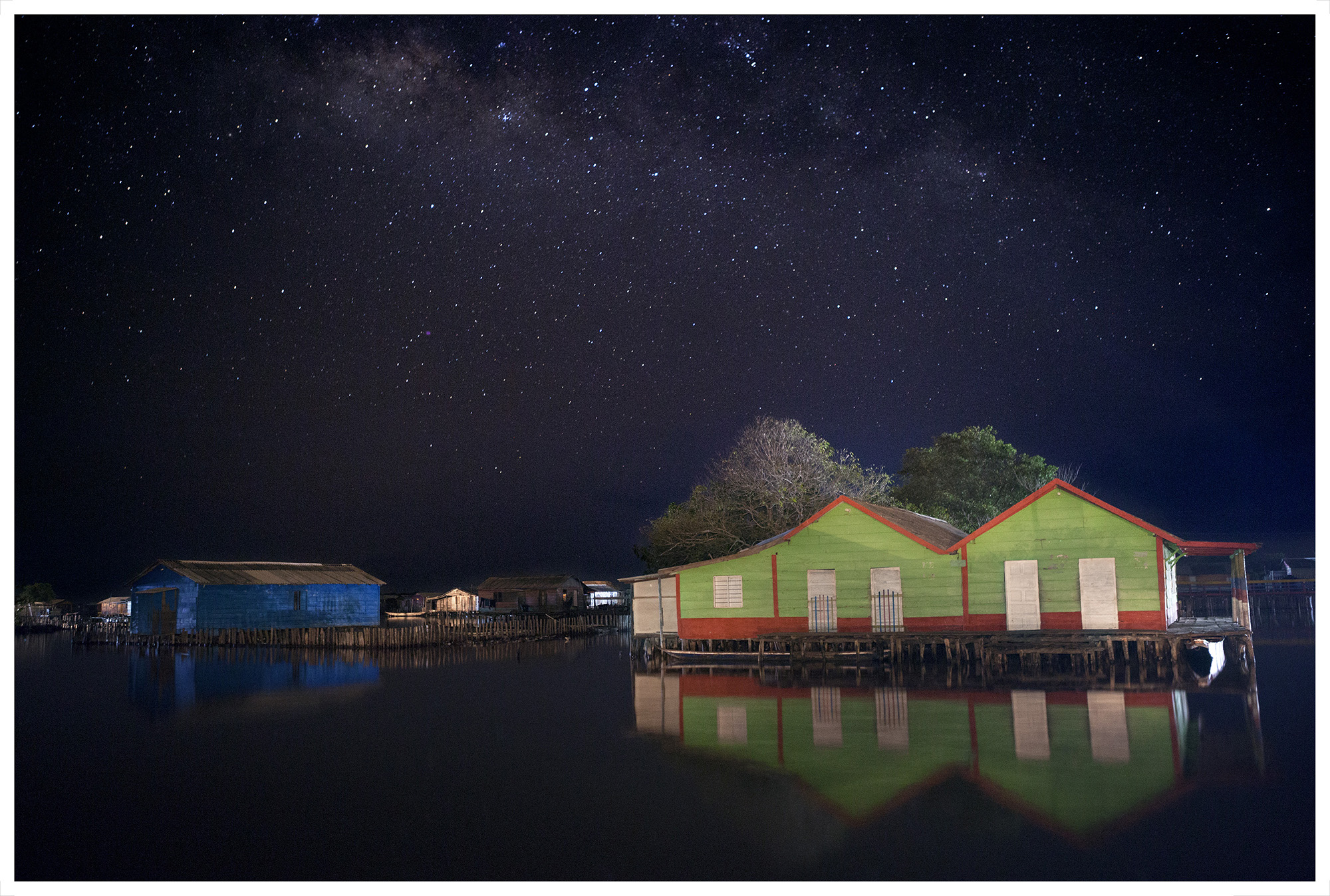 When we returned, I remember that one night I was sleeping in a hammock hanging in an abandoned school, where Isabel used to teach, and I was not able to sleep. I couldn't sleep because I had a lot of light upstairs: The Milky Way. Then I got up and started taking a series of photographs. After that I have done several in some parts of the country where life has been offended. In places where people yearn to return. That's why the skies of Nueva Venecia, where forty fishermen were killed, in the Serranía de Abibe, where I once walked with peasants fleeing because of the murder of eight people and so on... That's why the sky behind the church of Bojayá, where the FARC guerrilla went to ask for forgiveness in 2016. At night I stood there in front of the church in that village and concentrated on other things to think that if Bojayá voted 96 percent in the referendum saying “yes” to peace, it is because they are a people who hope that one day this country will improve and the lives of its sons and daughters will be respected a little more.
When we returned, I remember that one night I was sleeping in a hammock hanging in an abandoned school, where Isabel used to teach, and I was not able to sleep. I couldn't sleep because I had a lot of light upstairs: The Milky Way. Then I got up and started taking a series of photographs. After that I have done several in some parts of the country where life has been offended. In places where people yearn to return. That's why the skies of Nueva Venecia, where forty fishermen were killed, in the Serranía de Abibe, where I once walked with peasants fleeing because of the murder of eight people and so on... That's why the sky behind the church of Bojayá, where the FARC guerrilla went to ask for forgiveness in 2016. At night I stood there in front of the church in that village and concentrated on other things to think that if Bojayá voted 96 percent in the referendum saying “yes” to peace, it is because they are a people who hope that one day this country will improve and the lives of its sons and daughters will be respected a little more.
You have been traversing this country for more than twenty years. What changes have you seen in recent times, since the signing of the peace agreement, and how have these changes affected your work?
This is a very particular country because there was a referendum for peace and a peace process that everyone supported, but here many political and religious leaders were teaching people to hate. So, it is a country that is very polarized.
There is no doubt that the peace process alleviated many regions of Colombia and there are areas where they are really living a post-conflict reality: Montes de María, the Antioquia East, in regions of the Caribbean zone of Colombia. Obviously, there are still guerrillas like that of the ELN and the emergence of a number of groups in regions where they are above all else focused on the cultivation of coca leaf for cocaine production. So, there are regions of the country that are very complicated to enter: the western Pacific region of Colombia, the coasts of Nariño, Cauca and Valle del Cauca, the Chocó, the lower Cauca... almost all of them are associated with the issue of illegality, of drug trafficking.
Also, the border with Venezuela, which is Catatumbo and Arauca. And in some of them, not only because of the planting of coca leaves, but also because there is still a guerrilla like the ELN. So here there are many destabilizing factors. The riskiest areas to work as a journalist, and the ones I'm not going to almost, are those areas where there are several illegal armies, but also legal: Tumaco has 9,000 army personnel. Only one municipality. Of course, it's on the border with Ecuador and the number of disappeared is impressive. I would just like to be documenting all the positive experiences of resistance in Colombia or of survival of the people who, with music, with song, with dance, with poetry, with re-sowing the land, are betting on life.
I don't enjoy, one can never enjoy, going to a place to look for themes of pain. I enjoy looking for life. That's why in many moments, in the midst of situations of violence, what my portraits are trying to show is humanity and the dignity of people. That's why those portraits are loaded with feeling. I always say that I see with the left eye because it is closer to the heart. I've always tried to take pictures with a lot of feeling to tell people that the one who "clicks" is not the finger. What the finger is receiving are soul pulses and sometimes it is loaded with a lot of pain, but it has never given up hope that we can transform it. And this is not only transformed with a signature on a table in a peace process, this is transformed with a country in which the academy, the industries, the different churches, but especially the Colombian political class that, for me, as I tell you, bears the great responsibility for this country not being one of the best places for living in the world.
What stories of rebirth and caring for life do you have in mind that you have recently covered?
On many sides... that photograph is not in the exhibition, but, for example, the image of Ana Felicia Velázquez, in Mampuján. A woman I portrayed in 2010, she had fled on March 10, 2000. Ten years later they went back to the village to commemorate ten years not only since the massacre, but of having had to abandon their village.
The village was abandoned, the school full of bushes, the houses with large, leafy trees. Nature had regained space in the houses. And Ana Felicia was the only woman in all her village who had the trees cut down and brought elements from when she fled ten years ago: she brought a table, a tablecloth, a vase, a gobelin and two small paintings and reassembled the living room of her house. Ana Felicia had built it while working as a maid in Cartagena and Venezuela. One day she returned to the country, in 1999, tired of working as a maid in Maracaibo and had to leave everything with her people. But for me, to see her that day, in the middle of her house ten years after abandoning it and doing some portraits of her, was to understand the humanity and art of a woman like Ana Felicia. The only thing I was doing was "click", with the tip of the finger that received the sensations of the soul. But Ana Felicia, for me, was a work of art. The village of Mampuján is already rebuilt. Ana Felicia is not going to return because she is very old, her health conditions are not going to allow it, but her house is going to be the house of Mampuján's memory. I visited it last year in May and I have to tell you that it is a complete work of art.

And in many places... now in March I went up to the house of a peasant woman who had her father and mother killed in the area of Ciénaga Magdalena, in a vereda called La Secreta: Mercedes was a woman who at sixteen years old was orphaned with six other siblings; the youngest were triplets. The older brother was killed on the same day as her mother and father. And when the whole family was going to break up the surviving children, Mercedes told them not to. That their house was going to stay together. That they rather should help her get them through, but that the family was going to stay together. I knew the triplets and I have photographs of them when they were almost fourteen years old. I recently visited her. And now that I'm back, I saw the family multiply.
Each of the triplets, a decade later, has its own little house and Mercedes, who brought them up, has six children: they are a beauty. They may not have many material things, but they are living in peace. They are sleeping peacefully, which is what our peasants need. And so on, through many regions. There is a woman I saw getting married in the middle of the war... In Granada, Antioquia, Beatriz García and Óscar Giraldo did not stop their marriage even though they married while they were still collecting the dead among the people. People murmured because they were getting married in the middle of a tragedy: 258 houses totally and partially destroyed, 23 dead, 5 policemen and 18 civilians. And she arrived at the same church where the dead were being vigiled, and came in with a five-meter train to get married. And with the passing of the years I continue to visit her. It is to bet on life and understand that in this country it is love that defeats war.
The exhibition El Testigo will be at the Museo Claustro de San Agustín (Carrera 8 No. 7 - 21, Bogotá, Colombia) until December 30, 2019. Admission is free.









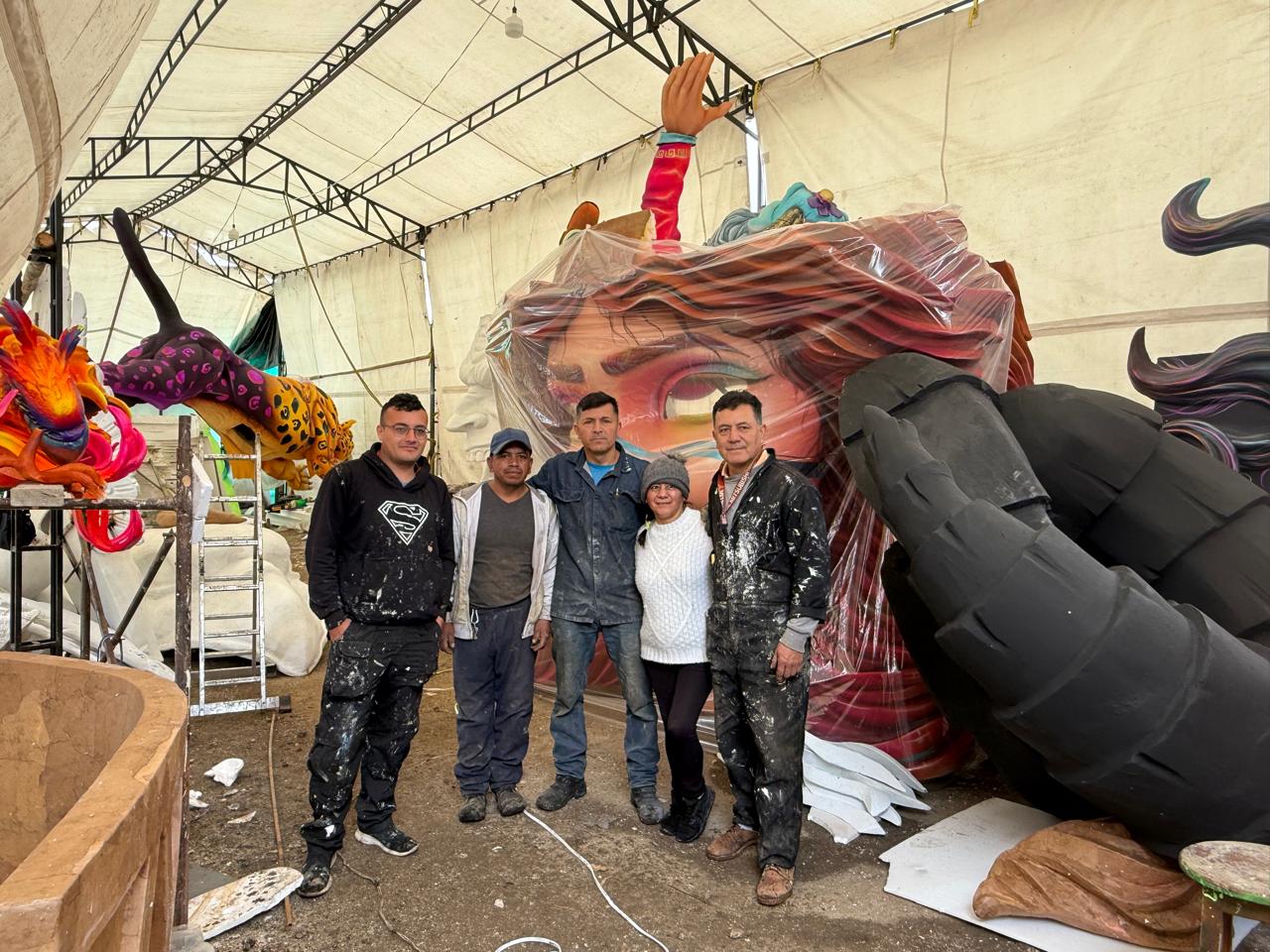

LEAVE A COMMENT: